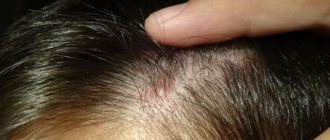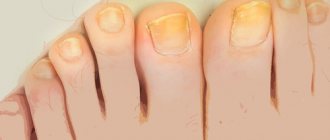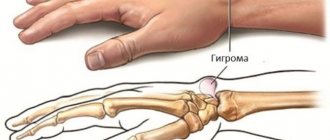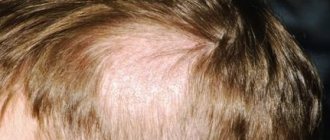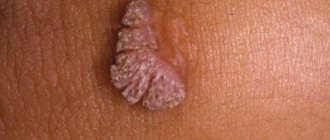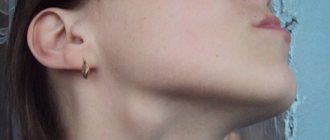Atheroma on the face is not just a cosmetic defect. It occurs due to blockage of the sebaceous glands. If infection penetrates inside, purulent inflammation may develop. Inflammation of atheroma on the face is very dangerous, especially if the process is located above the line of the mouth. This is due to the peculiarities of the blood supply to the head. The veins of the face drain into the venous sinuses of the skull, which leads to the rapid progression of the disease and the development of abscesses in the brain. The degree of danger of atheroma depends on other factors, including the size of the formation and the presence of underlying chronic diseases, such as diabetes. Therefore, when facial atheroma appears, treatment should only be carried out by a doctor.
Rice. 1 Facial atheroma occurs due to blockage of the sebaceous glands
Lump under the skin on the forehead
A ball or lump under the skin on the forehead under the skin can mean anything.
This includes a serious health condition such as cancer, a bone spur (osteoma), or just a sinus infection (sinusitis). Various bumps may appear between or above the eyebrows. A subcutaneous formation that appears on the forehead usually does not cause any complications, and most of them go away without any medical help. A common cause of this problem is a sebaceous cyst. This is a tumor on the skin that occurs due to inflammation of the sebaceous glands. These bumps form when pores become blocked and fill with sebum and other dead cells.
Treatment for lumps under the skin always depends on the cause. For mild cases, ointments can be used. In other cases, they will quickly go away on their own. You should consult a doctor if itching occurs, the lump does not go away for a long time or begins to spread to other parts of the body.
Atheroma (sebaceous cyst)
This is the most common cause of forehead balls or bumps. Cysts form on the sebaceous glands after they become clogged with yellowish sebum. They can go away on their own without medical help.
The cyst is not malignant and contagious. Atheromas grow slowly and are not life-threatening. Over time, they can become uncomfortable if their growth is not stopped. It is necessary to visit a doctor to make sure that the lump is not cancerous.
Treatment usually involves preventing severe symptoms and reducing the likelihood of future recurrences. The doctor may use a syringe to drain the atheroma or perform a surgical procedure. Topical and steroid medications may be used.
Osteomas develop from bone tissue. They may occur at birth or develop over time.
The cause is unknown, but it is believed to be an inherited condition.
Osteoma is not a health problem, and the lump may go away on its own in less than a year. Therefore, the treatment is only given to those who have cosmetic concerns. A surgical procedure may be recommended to remove the tumor.
Treatment of osteoma
Osteoma forms when new bone grows on existing bone. The condition is common in children and young adults, but is rare in older people. Osteoma is a benign tumor, not cancerous, does not spread to other parts of the body and can go away on its own. Therefore, treatment does not involve removing the tumor, but reducing pain, which is its most common symptom.
The following treatment can be carried out:
- Treat pain and allow swelling to go away on its own
- Perform surgery to remove it
- Use radiofrequency ablation (RFA).
Lipoma (wen) is a harmless fatty deposit under the skin. They are mild and most are painless. They are also easy to diagnose compared to other skin conditions. Lipomas are not harmful, but a dermatologist can remove them if necessary.
People of any age are susceptible to this problem. It is classified as a benign tumor and is not contagious. The following are the characteristic features of lipoma:
- It is soft and movable when touched
- Grows slowly and does not spread to other parts
- Manifests itself in the form of bumps on the forehead (although it can generally form on any part of the body)
- Located under the skin
- They appear pale compared to the surrounding skin.
A biopsy is performed to diagnose the condition. In mild cases, such a formation does not pose any health risks or complications and therefore does not require treatment. However, if symptoms are bothersome, your doctor may prescribe one or more of the following treatment options:
- Surgical procedure
- Steroid injection for inflammation, both in joints and soft tissues
- Liposuction, in which a syringe is used to remove the fat forming the lipoma through suction
- Ointment for pain, itching and swelling
Cancer refers to the formation of malignant tissue that begins to attack and damage neighboring cells. A common symptom is a painless swelling on the face. Cancer is a chronic disease. If you notice the following symptoms, you should seek medical help immediately:
- Painless lump on forehead
- A bump-like birthmark called melanoma
- Red dry bump
- A red, thick spot that may bleed frequently
- The spots increase in size
- Uneven spot.
The earlier cancer is diagnosed, the higher the chances of curing it. Depending on the type and severity, the doctor may prescribe chemical, radiation therapy or surgery to remove the formation.
Acne is a small, painful, red or pink bump on the forehead. They can appear as individual pimples or form groups. They form when skin pores become blocked and fill with dead cells and sebum. The resulting lumps can lead to acne or pimples.
The condition can be mild or severe. In the first case, a simple warm compress and aloe vera will help get rid of pimples and reduce the annoying urge to scratch them. On the other hand, severe acne can be treated with acne medications and antibiotics to reduce the chance of infection.
You should consult a doctor if symptoms persist or the pain and itching become unbearable.
Angioedema
Another possible cause of forehead lumps is angioedema, also known as angioedema, which involves swelling, itching, pain and burning. It can be caused by an allergic reaction to chemicals in food, insects, and medications that cause the body to release histamine.
Histamine in the body causes blood plasma to leak from the vessels into the skin, causing hives or angioedema. It may also be caused by a genetic disorder that may be inherited from parents.
Other reasons include;
- Pregnancy
- Anxiety or stress
- Extreme hot or cold temperature.
Treatment for angioedema will depend on its type and cause. However, common treatment options include:
- Avoid allergic triggers
- Antihistamines and steroids
- Automatic adrenaline injection for specific allergies.
For hereditary conditions, medications will be used to prevent and treat swelling.
Allergic reaction
An allergic reaction is a common cause of skin rashes and bumps. Lumps are usually accompanied by redness and swelling of the skin. An example of an allergic skin condition is allergic eczema.
Allergic eczema is a skin reaction that causes an itchy red skin rash. The rash may consist of raised red bumps that may ooze.
Avoiding the allergy-causing substance is fundamental to preventing a reaction. An example is maintaining a gluten-free diet for those with allergies to gluten, contact with animal dander, etc. Anti-itch and anti-swelling creams can be used for mild cases of rashes.
How to get rid of it and how to treat it?
Of course, if an incomprehensible lump appears on the forehead, on the top or back of the head, it is better not to guess what it is and when it will go away. The most sensible thing to do in this situation would be an unscheduled visit to the doctor - to start with a regular therapist or dermatologist. Afterwards, you may need to consult with other specialists.
Treatment for bumps on the head directly depends on the cause of their appearance:
- If the bulge occurs due to a blow (injury), you should immediately apply cold to the affected area. This will help reduce the lump, or even prevent its formation. The use of heat is strictly prohibited.
- If the lump is a benign tumor, you should definitely discuss the possibility of its removal with your doctor. Perhaps laser treatment or cryodestruction will be the best option in your situation and will help get rid of the unwanted bulge. By themselves, benign tumors on the head most often do not pose a threat to health, but they can be easily injured and inflamed, so it is better to get rid of them.
- If bites are suspected, it is necessary to determine which parasite caused such harm and take measures to combat it. In particular, if the bumps on the head appear due to lice, you need to purchase special anti-lice medications at the pharmacy and treat the head in accordance with the instructions. It is important not to forget to comb out nits and disinfect wardrobe items and bedding. Regular allergy medications will help relieve itching from bites and reduce their severity.
- Abscesses on the head require mandatory antibacterial therapy, and in such a situation it is most often systemic in nature. The patient will need to take a course of antibiotics, and then take care of their health in order to prevent the problem from reoccurring.
- As for enlarged lymph nodes, they do not require any targeted treatment other than therapy for the underlying disease. It is important not to heat, rub or massage the bumps under the skin in any way. But if suddenly the lymph node becomes inflamed and suppuration begins, surgical intervention may be necessary.
All methods of treating bumps on the forehead or back of the head can only be selected on an individual basis after accurately determining what exactly such formations are.
Hard bump on forehead
Hard lumps on the forehead that feel like bone in most cases indicate osteoma. Osteoma, as stated above, is a benign tumor that is the result of bone tissue growth. The tumor can be found in any bony part of the body, but is more common in the legs.
Osteoma is common in children and adults, but is less common in people over 50 years of age.
In severe cases, when the pain becomes unbearable, the lump becomes large and does not go away after a month, you should immediately consult a doctor. Treatment options include a surgical procedure to remove such a bone tumor or radiation therapy, where radioactive energy will be used to destroy excess tissue.
Bumps that go away and come back again
Recurring subcutaneous lesions should be a cause for concern. They indicate an infection that does not go away. A common cause of this problem on the face is a sebaceous cyst. These are purulent tubercles formed on the sebaceous glands or pores of the skin.
They are not cancerous and are caused by infection or blockage of the sebaceous glands. You should clean the skin area around the lump with antibacterial soap, apply a warm compress twice a day for 20 minutes for a week, and avoid scratching or squeezing as this increases the likelihood of infection.
You should consult a doctor for additional diagnostics if the swelling does not go away after doing all these steps.
Barley
This disease is widespread, almost more common than chalazion. When a stye occurs on the lower or upper eyelid, a painful lump occurs due to inflammation of the eyelash bulb (follicle). Both adults and children are susceptible to this disease.
Barley is an inflammatory disease that occurs due to blockage of the sebaceous duct, the secretion from which lubricates the eyelash, thereby protecting it from the effects of the external environment.
There are two types of stye: external, when the sebaceous gland becomes inflamed, or internal, resulting from inflammation of the meibomian gland.
At the first stage of the appearance of external barley, the patient feels the presence of a foreign body in the eye or a stabbing pain. With internal styes, the lump on the eyelid is not so noticeable, although it causes no less discomfort.
In the absence of treatment, a couple of days after the appearance of swelling and redness, a head of purulent contents appears on the lump, which spontaneously opens and goes away after a few days.
And yet barley heals better. Firstly, this will speed up recovery, and secondly, it will help avoid unpleasant complications, such as the development of chalazion. Moreover, if the stye does not go away on its own within 2 weeks, a visit to a specialist is required! An ophthalmologist will open the stye under local anesthesia and recovery will come very soon.
The complex of therapeutic measures for barley includes the use of various antibiotics in drops and ointments. For example, solutions of albucid, gentacymin, penicillin, erythromycin, as well as rithromycin and tetracycline ointments.
Bumps on the forehead
Lumps on the forehead are most likely caused by any of the following:
- Acne, which is red, inflamed pimples on the sebaceous gland caused by infection. They can go away on their own without medical help.
- Cysts are lumps that form when the sebaceous glands become clogged with dead tissue, cells, and sebum.
- A pustule is a form of acne. They have no visible pores, are closed, red in color and surrounded by inflamed skin
- Boils on the forehead, most of which are caused by bacteria and can appear on the thighs, armpits and buttocks
- Stress and hormone imbalance
- Heat rash and sunburn, common in hot areas, occur when the pores of the skin become blocked, making it difficult for sweat to exit the body.
Small itchy bumps
Small itchy balls are very common. They can be very painful and cause a lot of discomfort. Most of them do not require immediate medical attention, given the fact that they do not pose a health threat. But, of course, they have an impact on a person’s appearance and overall self-esteem.
Small, itchy bumps can be very contagious, such as the chickenpox or shingles viruses. Sometimes they can be triggered by heat rash or prolonged exposure to direct sunlight. These rashes are not harmful and can be treated with anti-itch ointments and creams.
Eating a balanced diet, drinking plenty of fruits and drinking fluids can also help keep the body functioning properly, strengthen the immune system and keep pores open. You should see a doctor if the rash continues for more than a week, as it is a sign of a medical complication.
Home Remedies
Mild manifestations of the problem can always be treated at home using simple and natural home remedies available. Treatment using these methods is concerned with treating the visible symptoms rather than the underlying cause.
Tomato mask is a good remedy for acne on the face. Tomato contains antioxidants that protect the skin from free radicals that cause acne. It also helps to balance the PH level of the skin, finally the tomato closes the pores, preventing bacterial infection, clogging of sebum and dead skin cells.
You need to apply the fresh tomato mask to your face and let it dry for 20 minutes before rinsing it off. Repeat this process twice daily for a week for optimal results.
Mustard powder
Mustard powder is an effective home remedy.
It contains salicylic acid, which is effective in treating acne, as well as omega-3, vitamin C, fatty acids and zinc, which are good for the skin. An even more effective remedy may be a mixture of mustard oil and honey. Apply this paste to the affected area, leave it for 20 minutes, then wash off. Repeat the procedure twice a day for a week to get the desired result.
Lemon juice
Fresh lemon juice can work wonders for acne on your face.
It may also be useful in treating recurring bumps and small itchy lumps. Lemon contains citric acid and is rich in vitamin C, which is beneficial for all skin types. Citric acid helps exfoliate the skin, which is an important part of treating the problem. It is also an astringent, which helps in drying the skin.
You need to cut a fresh lemon in half and wipe your face with it. Carry out the manipulation two or three times a day for a week.
Apple vinegar
This is one of the best treatment options for sebaceous cysts.
It contains acetic acid, which helps kill bacteria that cause infection. You need to soak a face towel in apple cider vinegar and place it on the affected area. You can secure it with a bandage and leave it overnight. Repeat daily for a week. You can also use a mixture of honey and vinegar, which will give faster results.
Applying clay to the facial skin helps in removing impurities, which include dead cells and tissue, sebum and bacteria that cause infection. This mask is also good for reducing inflammation and swelling.
You can make it even more effective by adding zinc oxide or sulfur.
The danger of atheroma on the face
Sebum and keratin masses accumulated in the atheroma capsule have a cheesy consistency. This is a favorable environment for the development of bacteria. An attempt to squeeze out the atheroma can lead to infection getting inside the capsule and causing suppuration. The main symptoms of its onset are:
- redness of the skin around the atheroma;
- pain in the affected area;
- Migraine-like headaches;
- temperature increase.
Inflamed atheroma can lead to phlegmon - inflammation of adjacent tissues without precise boundaries.
Rice. 3 Self-squeezing of atheroma usually leads to inflammation of facial tissues
Pathologies that cause a lump on the forehead to form
Lumps and lumps appear especially often on the frontal part of the head due to the development of the following pathologies:
- Atheroma. Blockage of the lumen of the excretory duct of the sebaceous gland by skin secretion is accompanied by the formation of a compaction, which in some cases goes away on its own. But generally, a bump on the forehead does not go away for several years and is characterized by slow growth. However, it does not pose a threat to the patient’s life and does not cause pain.
- Osteoma. The pathogenesis of its development is not fully understood. There is an assumption that it is hereditary. The tumor is formed from bone tissue. It does not cause painful manifestations, but the cosmetic defect creates the need for surgical intervention.
- Lipoma. A relatively harmless bump on the forehead that does not cause painful symptoms and is easily diagnosed during examination. At the same time, it can greatly increase in diameter, which causes a cosmetic defect. Upon external examination, it has the following distinctive features: upon palpation it is mobile, and its structure is soft and homogeneous; has a slow growth and does not spread to other parts of the body; visually resembles a bump received from a blow; located directly under the skin, which has a pale appearance compared to adjacent tissues.
- Neoplasm of a malignant nature. It has a long-term, chronic nature with subsequent involvement of neighboring tissues in the pathological process, causing morphological changes in cellular structures. Symptoms that necessitate contacting a medical facility: when a bump on the forehead does not go away for a long time, taking the form of a birthmark (melanoma develops); absence of pain at an early stage of development; the skin surface above the seal is dry and may peel; an increase in thickness and diameter causes bleeding; the formation has an irregular outline (does not follow the shape of a circle or a circle).
- Angioedema. This manifestation is better known as Quincke's edema. In the etiology of this condition, the main role is played by an allergic reaction to chemical compounds, foods, medications, as well as all substances that increase the concentration of histamine in the blood.
In addition to spherical seals, swelling, soreness, itching and burning appear on the facial area.
- Fibroma. This is a type of benign tumor that has a tendency to malignant degeneration (fibrosarcoma).
- A lump on the forehead, in both adults and children, can be the result of a mechanical injury or appear after an insect bite (mosquitoes, bees or wasps). Initially, the patient may experience pain, after which swelling appears, and itching occurs in the bite wound.
The choice of treatment method is made by the doctor after establishing an accurate diagnosis. Therefore, therapy will differ based on the cause of the development of the pathological process. Therapeutic measures to eliminate formed bumps in the facial area:
- If the tumor has formed as a result of mechanical damage (from an impact), a cold compress must initially be applied to reduce pain and swelling. In subsequent days, it is recommended to apply compresses with Bodyaga. In addition, dry heat can be used.
- If swelling appears as a result of an insect bite, the best solution to this problem would be cold lotions and taking drugs that block the production of histamine (Tavegil, Suprastin, Loratadine, Claritin).
- The development of Quincke's edema requires elimination of the source of the irritant, followed by symptomatic therapy and the use of antihistamines.
- Osteomas, fibromas or wen are removed during surgical therapy. Warts and papillomas are eliminated using laser technology.
- Oncological tumors cannot be cured with conservative methods, and therefore surgery is performed to remove them. Subsequently, chemotherapy is performed.
Lump on forehead under skin
Often, during a bruise or injury, a lump appears, and it is located right in the area of impact.
The lump can be in any part of the head and body, especially often on the forehead. But the appearance of such a swelling can be not only due to a bruise; in some cases, the lump grows due to diseases and other factors that are important to diagnose.
It is imperative to determine the reasons when swelling appears under the skin.
Reasons for development
Factors contributing to the development of atheroma on the head are:
- metabolic disorders leading to changes in the properties of the secretion of the sebaceous glands;
- hair dyeing, head shaving with damage to hair follicles;
- hyperhidrosis (especially in combination with seborrheic dermatitis);
- inflammatory diseases of the scalp;
- low-quality hygiene products for hair care;
- Irregular hair washing with the accumulation of viscous oil on the scalp.
Atheromas often form not only on the scalp, but also around the ears and on the chin.
Main reasons and types
Checkers on the forehead under the skin often appear above the eyebrows, and the cause in most cases is injury, in the form of a blow or bruise.
Such a formation will hurt, but if treated correctly, the swelling will go away faster than other types.
In some cases, formations appear on the forehead due to the peculiar structure of the head.
Sometimes this phenomenon is hereditary. In this case, there is no need to panic or worry, especially if the hump does not cause pain or discomfort.
If the appearance of a lump in the frontal part is quite sudden, then it is better to consult a doctor quickly to eliminate the possible consequences of inaction.
If we exclude heredity and injury, then the root cause may be clogging of the sebaceous glands.
In this case, a wen appears under the skin, which can grow over time. In such a formation, pus begins to appear under the skin.
The lump with pus must be removed to avoid infection with viruses and bacteria. It is very rare, but the formation of hemangioma is possible.
These tumors can be treated with fairly simple methods, the main thing is to start timely therapy.
Lumps in the forehead area that do not hurt must be diagnosed, as they may be malignant.
This pathology is called osteoma of the frontal sinus, but if you consult a doctor in time, you can get rid of it.
More often than adults, children come home with bumps on their foreheads. This is due to their hyperactivity, as well as their inability to behave carefully.
As a result of this, children receive various blows and other injuries, after which blood vessels burst, tissues under the skin accumulate blood and begin to form in the form of tubercles.
This condition is called hematoma. If a lump appears above the eyebrows in children, then there is very little harm from such a formation, since the bone is powerful and you can get rid of the lump very quickly.
If a growth appears on the eyebrow, then parents do not need to panic. It is enough to provide first aid, which will immediately improve the child’s condition.
To do this, you can use cold applied to the eyebrow. It should be noted that in the case of a red tint or a wound on the formation, it is necessary to use antiseptic local preparations, and if the wound is large, then it is better to immediately go to the emergency room.
Getting rid of cones
If the lump is a hematoma as a result of an impact, then in a short time you can get rid of it using this method:
- Initially, you need to apply cold to the damaged area.
- It is necessary to apply an ointment that can resolve the swelling on the head. The same method can be used if a lump appears under the eyebrow.
- This method of treatment will need to be applied 2 times a day, as well as other means of traditional or traditional medicine.
If the lump hurts due to injury, then you can use medications, namely ointments.
Such substances can be purchased at any pharmacy and are recommended for use by both adults and children.
When choosing an ointment, you should give preference to homeopathic types, which include “Traumel S”, “Rescuer”, “Lioton”.
Among the folk remedies for hematomas, you can use heparin ointment. This medicine relieves inflammation and is also used to prevent hemorrhage.
As a home remedy, you can draw a grid of iodine, after which the pain and swelling will go away in a few days. There should be a pause of about 12 hours between grids, so it is better to draw it before bed.
Medications for internal use can be used in cases where the growth is hard, and if softness is felt under the skin on the forehead, it is better to consult a doctor.
If the purulent formation does not need to be removed, the doctor will prescribe a complex of vitamins and restoratives.
The treatment process as a whole depends on the causes of the formation of tubercles in the frontal part.
For example, if the cause is injury or allergies, as well as furunculosis, then you can use home methods for treatment.
In other cases, it is necessary to entrust the matter to doctors. If the cause is caused by an allergy, then you will need to use sorbents and antihistamines that will get rid of the formation.
If there is redness around the lump, and its structure is soft, then it is an abscess.
For treatment, you need to undergo tests that allow you to identify the pathogens. After this, antibiotics and drugs to strengthen the immune system are prescribed.
To quickly remove pus from the lump, you need to use special ointments that are applied to the skin.
In certain situations, treatment is only possible with surgical methods. After surgical intervention, doctors use an antiseptic and bandages, which can disinfect the wound and promote its rapid healing.
If bumps appear not for the first time or they appear on the forehead in some places at once, then the cause may be a pathology of the internal organs.
In this case, doctors prescribe a comprehensive examination. Small formations occur due to the appearance of fat under the skin, in other words, wen.
These bumps can be avoided by using preventative measures. It is enough to monitor skin hygiene in the forehead area.
It is better not to remove fat deposits yourself, as you can get infected and become inflamed.
As a rule, the wen is removed using cryodestruction, which is almost not felt by the patient.
If the cause is inflammation of the lymph nodes, then this is a secondary pathology and it is necessary to act on the root cause.
Diagnosis must be carried out, and treatment will be individual for each person.
When a boil appears, you should use 3% hydrogen peroxide for local treatment, as well as calendula-based products.
The lump is treated 3-4 times a day until the inflammation disappears.
Traditional methods
When the lump grows, but it is not possible to use ointments and other medications, then you need to use traditional methods of treatment.
Among them there are several effective ones that cope with such education:
- Plantain. Such a plant can relieve pain and inflammation in the shortest possible time. To do this, you can apply a fresh leaf or crush it and use it as a compress.
- Potato. This root vegetable has anti-inflammatory effects. For therapy, you need to grate the plant to make a porridge, then wrap it in cloth and place it on the growth for 30 minutes. The compress is used twice a day.
- Cabbage. This vegetable is familiar to many from childhood. To relieve swelling in the frontal part, you need to apply a leaf to the bump. In some cases, you can make and take a vegetable-based decoction.
For prevention, first of all, you need to be careful and not damage your head, including your forehead.
Diagnosis of atheroma on the face
Atheroma looks like a small subcutaneous ball. The tumor itself does not resolve and gradually increases. With long-term existence, atheroma on the face can reach 7 cm in diameter. On its surface you can always see a black dot that blocks the sebaceous duct. Atheroma has clear boundaries and a spherical shape. The patient does not feel pain upon palpation. Visually, atheroma is similar to lipoma, hygroma, fibroma, hemangioma, so a doctor must make an accurate diagnosis. If there are difficulties in diagnosis, an MRI may be prescribed to determine the nature of the tumor. After removal of any formation, including atheroma, a histological examination is carried out.
Rice. 2 Atheroma looks like a small ball under the skin of the face
Lump on forehead under skin
Often, during a bruise or injury, a lump appears, and it is located right in the area of impact.
The lump can be in any part of the head and body, especially often on the forehead. But the appearance of such a swelling can be not only due to a bruise; in some cases, the lump grows due to diseases and other factors that are important to diagnose.
It is imperative to determine the reasons when swelling appears under the skin.
Prosyanka
This is one of the most harmless bumps, the appearance of which on the eyelid does not cause any trouble other than aesthetic discomfort. Millets, also known as milia, come in different sizes. From the smallest - smaller than a poppy seed, to quite large - the size of an average grain of rice. Milia can appear on both the lower and upper eyelids with almost equal frequency. At their core, they are whiteheads localized in the eye area.
Milia can appear in anyone, even in those who have never experienced skin problems. It is better to remove millet from a cosmetologist, because only a specialist can guarantee safety.
To prevent milia, you need to monitor your diet and from time to time make masks to exfoliate dead skin particles that can close pores and clog the ducts of the sebaceous glands.
Main reasons and types
Checkers on the forehead under the skin often appear above the eyebrows, and the cause in most cases is injury, in the form of a blow or bruise.
Such a formation will hurt, but if treated correctly, the swelling will go away faster than other types.
In some cases, formations appear on the forehead due to the peculiar structure of the head.
Sometimes this phenomenon is hereditary. In this case, there is no need to panic or worry, especially if the hump does not cause pain or discomfort.
If the appearance of a lump in the frontal part is quite sudden, then it is better to consult a doctor quickly to eliminate the possible consequences of inaction.
If we exclude heredity and injury, then the root cause may be clogging of the sebaceous glands.
In this case, a wen appears under the skin, which can grow over time. In such a formation, pus begins to appear under the skin.
The lump with pus must be removed to avoid infection with viruses and bacteria. It is very rare, but the formation of hemangioma is possible.
These tumors can be treated with fairly simple methods, the main thing is to start timely therapy.
Lumps in the forehead area that do not hurt must be diagnosed, as they may be malignant.
This pathology is called osteoma of the frontal sinus, but if you consult a doctor in time, you can get rid of it.
More often than adults, children come home with bumps on their foreheads. This is due to their hyperactivity, as well as their inability to behave carefully.
As a result of this, children receive various blows and other injuries, after which blood vessels burst, tissues under the skin accumulate blood and begin to form in the form of tubercles.
This condition is called hematoma. If a lump appears above the eyebrows in children, then there is very little harm from such a formation, since the bone is powerful and you can get rid of the lump very quickly.
If a growth appears on the eyebrow, then parents do not need to panic. It is enough to provide first aid, which will immediately improve the child’s condition.
To do this, you can use cold applied to the eyebrow. It should be noted that in the case of a red tint or a wound on the formation, it is necessary to use antiseptic local preparations, and if the wound is large, then it is better to immediately go to the emergency room.
What are closed comedones and why is it important to remove them?
Closed comedones are non-inflamed cysts that arise as a result of the accumulation of sebaceous gland secretions at the mouths of the sebaceous gland duct. Normally, skin secretions freely come to the surface of the skin without getting stuck in the ducts.
Closed comedones are not amenable to simple mechanical extrusion, because... have no free exit. In essence, it is a sebaceous plug that has no exit through the natural sebaceous duct.
They are located in seborrheic areas, most often in the forehead and cheeks.
How are closed comedones formed?
The mechanism of formation of white comedones involves 2 disorders:
- Hyperkeratosis - a violation of the exfoliation of keratinized cells inside the ducts of the sebaceous glands, scales accumulate and block the duct;
- Changes in the composition of sebum - it becomes thicker and denser, gluing the scales together, making it even more difficult for skin secretions to come out.
Closed comedones are formed in the presence of both disorders, as well as due to the narrowness of the excretory ducts of the sebaceous glands. The release of the contents of the pores becomes impossible and a blockage forms.
Why you need to remove closed comedones
According to the international classification of acne, the formation of comedones is the zero or initial stage of acne development. Treatment for comedones is necessary to prevent the development of more severe forms of acne.
Getting rid of cones
If the lump is a hematoma as a result of an impact, then in a short time you can get rid of it using this method:
- Initially, you need to apply cold to the damaged area.
- It is necessary to apply an ointment that can resolve the swelling on the head. The same method can be used if a lump appears under the eyebrow.
- This method of treatment will need to be applied 2 times a day, as well as other means of traditional or traditional medicine.
If the lump hurts due to injury, then you can use medications, namely ointments.
Such substances can be purchased at any pharmacy and are recommended for use by both adults and children.
When choosing an ointment, you should give preference to homeopathic types, which include “Traumel S”, “Rescuer”, “Lioton”.
Among the folk remedies for hematomas, you can use heparin ointment. This medicine relieves inflammation and is also used to prevent hemorrhage.
As a home remedy, you can draw a grid of iodine, after which the pain and swelling will go away in a few days. There should be a pause of about 12 hours between grids, so it is better to draw it before bed.
Medications for internal use can be used in cases where the growth is hard, and if softness is felt under the skin on the forehead, it is better to consult a doctor.
If the purulent formation does not need to be removed, the doctor will prescribe a complex of vitamins and restoratives.
The treatment process as a whole depends on the causes of the formation of tubercles in the frontal part.
For example, if the cause is injury or allergies, as well as furunculosis, then you can use home methods for treatment.
In other cases, it is necessary to entrust the matter to doctors. If the cause is caused by an allergy, then you will need to use sorbents and antihistamines that will get rid of the formation.
If there is redness around the lump, and its structure is soft, then it is an abscess.
For treatment, you need to undergo tests that allow you to identify the pathogens. After this, antibiotics and drugs to strengthen the immune system are prescribed.
To quickly remove pus from the lump, you need to use special ointments that are applied to the skin.
In certain situations, treatment is only possible with surgical methods. After surgical intervention, doctors use an antiseptic and bandages, which can disinfect the wound and promote its rapid healing.
If bumps appear not for the first time or they appear on the forehead in some places at once, then the cause may be a pathology of the internal organs.
In this case, doctors prescribe a comprehensive examination. Small formations occur due to the appearance of fat under the skin, in other words, wen.
These bumps can be avoided by using preventative measures. It is enough to monitor skin hygiene in the forehead area.
It is better not to remove fat deposits yourself, as you can get infected and become inflamed.
As a rule, the wen is removed using cryodestruction, which is almost not felt by the patient.
If the cause is inflammation of the lymph nodes, then this is a secondary pathology and it is necessary to act on the root cause.
Diagnosis must be carried out, and treatment will be individual for each person.
When a boil appears, you should use 3% hydrogen peroxide for local treatment, as well as calendula-based products.
The lump is treated 3-4 times a day until the inflammation disappears.
Traditional methods
When the lump grows, but it is not possible to use ointments and other medications, then you need to use traditional methods of treatment.
Among them there are several effective ones that cope with such education:
- Plantain. Such a plant can relieve pain and inflammation in the shortest possible time. To do this, you can apply a fresh leaf or crush it and use it as a compress.
- Potato. This root vegetable has anti-inflammatory effects. For therapy, you need to grate the plant to make a porridge, then wrap it in cloth and place it on the growth for 30 minutes. The compress is used twice a day.
- Cabbage. This vegetable is familiar to many from childhood. To relieve swelling in the frontal part, you need to apply a leaf to the bump. In some cases, you can make and take a vegetable-based decoction.
For prevention, first of all, you need to be careful and not damage your head, including your forehead.
Parents should tell their children how to behave during games. Every person needs to monitor their diet, which should be balanced, healthy and rich in plant foods.
It is especially important to practice personal hygiene of the head and skin; this will get rid of possible edema, swelling and wen in the frontal area.
If the described methods do not help, the treatment does not produce results, and constant pain occurs, then you should quickly consult a doctor.
The sudden appearance of a lump can mean serious illnesses and disorders.
Treatment
The most effective way to remove atheromas with minimal risk of recurrence is radio wave excision using the Surgitron device (USA). The procedure does not require shaving the hair; removal takes place under local anesthesia in 30 minutes. Bleeding does not occur due to instant coagulation of blood vessels. The scalp and hair are not damaged. Removal of the formation is non-contact; after the procedure, the doctor carries out an antiseptic treatment and a follow-up examination of the patient. The procedure is outpatient and does not require hospitalization.
